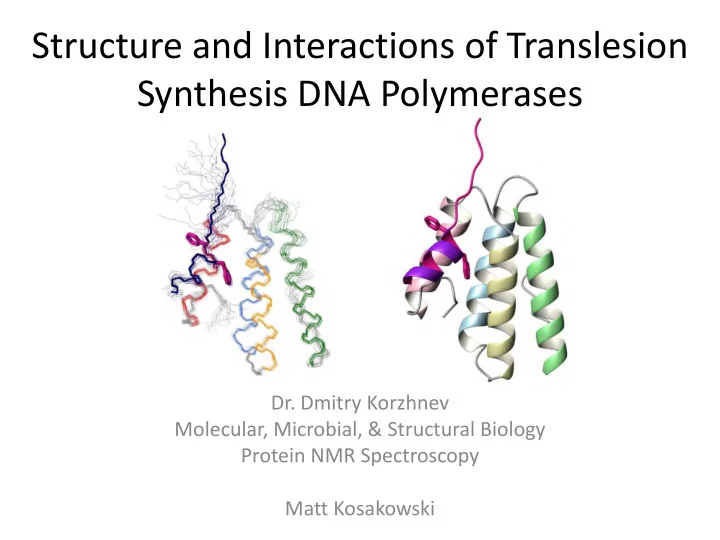

Structure and Interactions of Translesion Synthesis DNA Polymerases Dr. Dmitry Korzhnev Molecular, Microbial, & Structural Biology Protein NMR Spectroscopy Matt Kosakowski
What are TLS DNA Polymerases? • They are a key component of DNA replication pathways. Translesion synthesis is a DNA damage tolerance process. • However, certain types of DNA damage (lesions, dimers) persist and can halt DNA replication. Replicative DNA polymerases, cannot bypass most types of DNA damage due to restricted active sites. • Thus, organisms have evolved DNA damage tolerance pathways, which employ certain TLS enzymes that temporarily leave DNA damage unrepaired. • TLS polymerases have relaxed active sites that can replicate through various types of DNA damage. However, they replicate undamaged DNA at an extremely low fidelity, incorporating errors roughly every 10 to 1000 base pairs.
DNA Polymerases Bulk DNA Replication Translesional Synthesis Replicative B-family: TLS Y-family: Pol δ , Pol ε Rev1, pol η , pol ι , pol κ TLS B-family: Pol ζ • High fidelity, low error rate, about one in • Low fidelity, high error rate, one in every every 10 6 to 10 8 base pairs. 10 to 1000 base pairs. • Contains 3’ to 5’ proofreading activity • No proofreading activity • Restricted binding site, cannot bypass • Relaxed binding site, can bypass DNA DNA lesions. lesions • Therefore proceeds more slowly/ • Effective at replicating highly damaged ineffective in highly damaged DNA DNA, however is mutagenic and can incorporate new mutations in the DNA through mismatch base pairs.
Basic Mechanism of TLS - Eukaryotes • The switch to TLS polymerases is facilitated by interaction with PCNA, a ring shaped protein involved in replication, that otherwise serves as an activator and binding platform. • Upon mono-ubiquitination of PCNA at lysine 164 at a stalled replication fork, replicative polymerases are exchanged for TLS polymerases. Pol ζ /rev1 TLS branch accounts for 90% of mutations introduced in genomic DNA. DNA damage tolerance pathways and PCNA ubiquitination
Basic Mechanism of TLS -Eukaryotes • Upon PCNA mono-ubiquitination, one or multiple TLS polymerases are recruited to the site of DNA damage, where they replace replicative polymerases, Pol δ and Pol ε . • Pol ζ extends • Pol η , Pol ι , Pol κ are inserters • Rev1 structural, interacts with all other proteins
Research Question • Why is any of this important? – The translesional synthesis pathway is responsible for up to 90% of mutations introduced into the genome. – DNA damage leads to TLS replication which leads to more mutations, etc., resulting mutagenesis and of tumor cells. • What are the specific protein-protein interactions responsible for the recruitment of TLS enzymes, specifically error-prone Rev 1 and Pol ζ? • Application - Interfere or inhibit the recruitment of TLS enzymes in highly mutated genomes in order to sensitize cancer cells to chemotherapy.
The Project HLTF (Mms2/Ubc13) Rad18 SHPRH (Rad6) (Mms2/Ubc13) Interactions between proteins involved in TLS Domain architecture of TLS polymerases • TLS is coordinated through an intricate network of protein-protein interactions. Determining a detailed, structural characterization aimed at understanding these mechanisms is our goal. • TLS polymerases contain several binding domains and motifs that facilitate their interaction with each other and with PCNA. We can find the specific amino acid sequence of these domains using protein NMR spectroscopy.
Protein NMR • What is protein NMR? NH TROSY - scPCNA (100 kDa) – “Fingerprint” of a protein – Each peak represents an 108 amino acid – Can involve different 110 techniques and methods depending on size of the 114 protein sample and 15 N [PPM] 118 resonance assignments. – Use of N15 and C13 122 labeled protein to map chemical shifts, labeled 126 amine groups resonate at a different frequency 130 – Requires highly purified 134 protein grown on isotopic media. 10.0 9.0 8.0 7.0 6.0 1 H [PPM]
Work and Data • Structural biology labs are very slow! • Worked specifically on hPCNA, Polζ hUBZ, and Rev1 hPAD protein domains. • Grew both labeled and unlabeled samples of proteins via transformation of e. coli w/ protein plasmid, spun down • Isolated protein via Ni 2+ column, TEV and DDT enzyme cleavage and FPLS gel filtration • Collected fractions and ran samples on gel electrophoresis • Concentrated for NMR spectroscopy or titrations
hPAD FPLC Gel Fractions Rev1 hPAD 1 2 3 4 5 6 7 8 9 10 domain ~20 KDa hPAD HSQC Spectrum 15 N 1 H
Speculations • Titrations – Hypothesize that Polζ UBZ binds ubiquitin to Rev1 hPAD domain – Upon addition of substrate, signals shift – Can map binding interface by watching peaks move
Citations/Special Thanks • Image Sources – Chang, Cimprich (2009) Nat. Chem. Bio 2, 82-90 – McCulloch & Kunkel (2008) Cell Research 18, 148-161 – Sale, Lehmann, Woodgate (2012) Nat. Rev. MCB 13, 141-152 – Lehmann et al (2007) DNA Repair 6, 891-899 – Guo et al (2009) Cell. Mol. Life. Sci. 66, 2363-238 • Thank you to Dmitry, Irena, Yulia, Sasha, Luciana and Brandon for the wonderful experience of working with you in the lab. • Have a great rest of the summer!
Recommend
More recommend